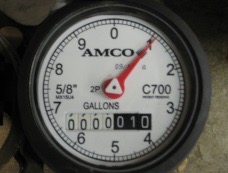Do you think you have a leak?
You can monitor your water use by reading your meter. Almost all water meters have a built-in low-flow indicator or leak detector.


If you look at your meter, there will be a small star-shaped wheel on the face. This little wheel turns when there is water flowing— even a very small amount.
To perform your own test for leaks, turn off all of the following:
- Water faucets (inside and outside the house)
- Showers
- Washing machine
- Dishwasher
- Irrigation system
If the star-shaped wheel is moving slightly, you may have a leak.
Next, you can narrow down where the leak is by turning individual valves on and off. For example, if you turn off a valve to an outdoor irrigation system and the low-flow indicator stops, then you know the leak is downstream from that particular valve.
Toilets are often a source of water leaks in the home. An easy way to check whether your toilet is leaking is to place some food coloring in the tank when it is full. Then wait a minute or two and check whether you begin to see colored water in the bowl. If so, then there may be a problem with the toilet.
Once you find the possible source of the leak, you will have to decide whether you can repair it yourself or need to call a professional for further assistance.
A leaky toilet may waste up to 200 gallons per day. That’s approximately 73,000 gallons per year.
Finally, consider the following example. You have a single, leaky faucet in your home. It drips 20 times per minute. That’s 28,800 drips per day (i.e., 20 drips/minute x 60 minutes/hour x 24 hours/day). In one year, you will lose approximately 925 gallons of water from this one faucet.
